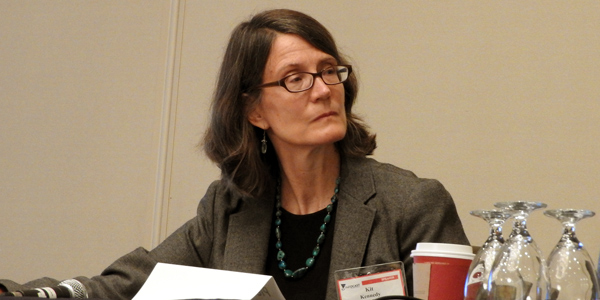By Rory D. Sweeney
TEANECK, N.J. — Although states are competing to be next in the water to develop the East Coast’s offshore wind, industry participants agreed last week that coordination and collaboration will be key for long-term success.
Stakeholders in the fledgling industry met last week at Infocast’s Offshore Wind Implementation Summit to discuss the gamut of issues, from workforce development and environmental concerns to grid interconnection and financial considerations.
While state officials have described themselves as in a competition to follow up on Rhode Island’s 30-MW Block Island project — the East Coast’s first OSW farm — speakers said states would be wiser to instead combine and conquer.
“I hope we can kind of get away from this concept of ‘one state’s going to be the winner in this race to build offshore wind.’ I think if we do it right, all states will benefit, and there’s a great benefit to coordinating ocean planning,” said Kit Kennedy, a senior director in the Natural Resources Defense Council’s Climate & Clean Energy Program. “In many ways, it’s up to the states to work together on ocean planning. We’re looking to you to be the leaders of this field right now because there’s a vacuum at the federal level.”
Brian Sabina, senior vice president of economic transformation for the New Jersey Economic Development Authority, predicted that as the industry grows, it will see beyond state-level competition to measure itself against international players.
“When you start to take that lens, regional cooperation becomes a lot easier,” he said.
“It is kind of competitive … but we really do believe the regional approach makes sense,” said Paul Baldauf, an assistant commissioner of the New Jersey Department of Environmental Protection. “If you look at some of the wind maps from Maine down to Carolina, it doesn’t necessarily matter where that lease is. Multiple states can benefit from it; they all need to have input.”
Coordination is also preferable for finer details, speakers said. Ross Gould, energy sector program manager for the Workforce Development Institute, pointed out that many politicians and union bosses will need to expend political capital to overcome obstacles, and that will likely require promising jobs.
“Now we’re left with the tough question that we have all these promises in all these states, but there’s only a finite amount of jobs,” he said. Collaboration will be key, he said, “to help figure out who can do what and where these jobs can go so that as many people as possible are able to go back and say, ‘I fulfilled my promises.’”
Permitting and oversight will also benefit from collaboration to avoid wasting money on collecting unnecessary data and being able to differentiate between “real” and “perceived” risk, said Mary Boatman, environmental studies chief at the federal Bureau of Ocean Energy Management’s Office of Renewable Energy Programs.
Collaboration will also help ensure that all methods, technologies and data collected are “scientifically defensible” under scrutiny at permitting meetings, said Vince Guida, a research fisheries biologist for the National Oceanic and Atmospheric Administration’s Northeast Fisheries Science Center in Sandy Hook, N.J.
Markian Melnyk, president of Atlantic Grid Development, advocated coordination of offshore transmission facilities rather than allowing generators to build their own private lines back to shore. Such coordination, a keystone of his company’s Atlantic Wind Connection project, would organize the offshore network into an extension of the onshore transmission grid to prevent lines crisscrossing on the seafloor and other unforeseen impacts that create conflicts with other industries, such as commercial offshore fishing.
“So at the moment, some of these tensions with commercial fishermen seem very fraught, but as we go, and as actual projects are built, I think we’re going to see that they can be planned, built and communicated in [ways] which are consistent with commercial fishing, and that’s going to be very positive,” Kennedy said.
Curtis Fisher, executive director for the National Wildlife Federation’s Northeast Regional Center, pointed out that the developers of the Block Island project are proud to say they lost money in delaying their project when a whale was sighted in the area.
“If you can parse out things that benefit the entire region versus things that might be specific to certain states, you can leverage those resources and really come up with a plan and be able to get there a lot quicker than you could as individual states,” Baldauf said.
He confirmed the observations of several project developers that the industry appears to be finally taking off after years of promising announcements that never went anywhere.
“Truly, this is the first time that things are really moving. [Developers are] coming in, asking environmental questions, trying to get an idea of what they’re going to have to comply with. They’re telling us what their plans are. If they’re further along, some of them have set up offices in N.J. They’re looking [for] places where they possibly could store equipment, manufacture equipment, so we’re moving. And that’s very positive. To be quite honest, once the two leases were [announced] in 2014, it’s been kind of glacial,” he said, referring to leases that were awarded in 2015 to RES America Developments and US Wind. “We haven’t moved that quickly, but now things are starting to move. And I think that’s up and down the East Coast.”





